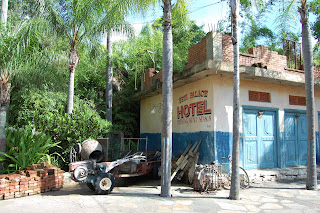Those of us in Serka Zong to catch the Flying Yak to Everest Base Camp must first check in with the Himalayan Escapes Booking Office. Himalayan Escapes organizes a number of tours and expeditions in the nearby mountains, but the one departing today is among their most popular offering: Expedition Everest.
The Booking Office is a cramped space, but serves its purpose. A look around the office reveals dozens of tiny details, all of which help tell the story of this place. Clockwise from the top left, look for a portrait of the Rajah of Anandapur and his wife, the first rupee they ever earned, old photos from their first expedition, a business license, alerts for trekkers, a map of the Himalayan region, a pack covered in patches from past trips, a computer and radio (older models, but still functional) and a safe.
On the wall to the right, you'll also find this letter from a Colonel Edward Blanchard (fictional) to the owners of Himalayan Escapes, identified as Norbu and Bob. It's a great example of how Imagineering storytelling is revealed through details.
In the backstory developed during production on the Expedition Everest attraction, a complete history was imagined for entrepreneurs Norbu, a native Anandapuri, and Bob, a Brit, and how they came together to build the business known as Himalayan Escapes. Stories like this serve as a guide for the various Imagineering disciplines involved in creating an attraction. With everyone following the same blueprint, every element ultimately works in unison to help tell the story.
The backstory for Expedition Everest: Legend of the Forbidden Mountain also describes that Himalayan Escapes operates a number of different tours. This part of the story is brought to life not only in the "temporary" banners and signs welcoming the Expedition Everest group, but also in details like this tour board in the Booking Office. It lists all the tours currently underway, along with their status, number of members and staff, the name of the guide and their current location. Expedition Everest is listed on the top row, with the current location being Serka Zong. Our tour is about to depart.
Patches and stickers displayed in the office also allude to previous tours offered by Himalayan Escapes, such as the Anandapur Polo Club Expedition and All American Women's Expedition, as well as certain affiliations, like the Anandapur Mountaineering Association. Look closely, and you may also discover a bit of Hidden Disney in the patch for the Mouseketeer Mountaineer Expedition.



















































